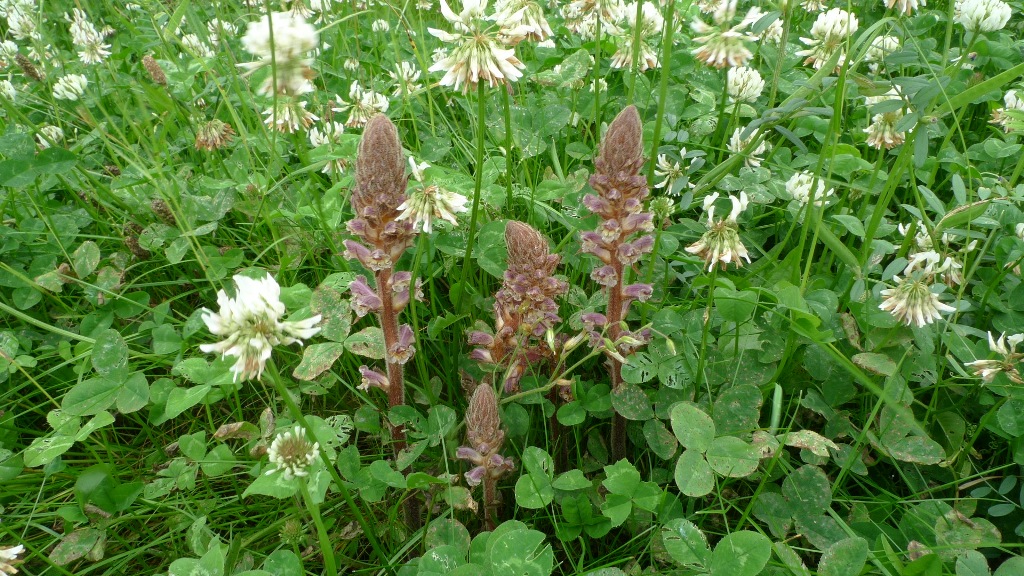
The Orobanchaceae or Broomrape family, has been seperated from the former Scrophulariaceae as it was:
‘a long-expressed opinion that these semi-parasitic Scrophulariaceae (tribe Pedicularieae) should be placed with the totally parasitic Orobanchaceae, which was confirmed by molecular studies’ (in Stace).
In former posts I’ve covered the Veronicaceae as well as Plantaginaceae which also split from the once much larger Scrophulariaceae family.
These are fascinating plants and in this post I hope to find out about all their uses to men as well as for wildlife and their interacting hosts.
Click links in the contents for more info and pictures from various websites. The scientific name usually has a link from the Online Atlas of the British Isles and Irish Flora. The common name mostly has a UK link or Wikipedia.
Background colours are meant for easier reading. A pink background means a warning (such as poisonous!) or medicinal use, green for edible, ornamental or other uses and blue for habitat where it can be found in B.I. , and just for interesting facts or wildlife use.
If the plants are found in the Flora of Birmingham and the Black Country a FBBC will be added behind the Common name in the contents page below.
Pictures with thanks by Matt Summers (M. S.), Mike Poulton (M. P.) of Ecorecord and Wikipedia Commons.
Their are now 10 genera in the Orobanchaceae or Broomrape family, described in Stace:
Contents:
Melampyrum spp or Cow-wheat
- M. cristatum or Crested Cow-wheat
- M. arvense or Field Cow-wheat
- M. pratense or Common Cow-wheat with 2 ssp.: – ssp. pratense FBBC and – ssp. commutatum
- M. sylvaticum or Small Cow-wheat
Euphrasia spp or Eyebrights
This is a complex genus with many species as well as hybrids! Stace divides them in 3 groups to make them easier to identify. Most species listed below have a narrow range where they grow.
Group 1: Subsection Euphrasia
- E. officinalis sensu lato or Common Eyebright FBBC
- E. rivularis or Cumbrian Eyebright
- E. vigursii or Cornish Eyebright
Group 2: Subsection Euphrasia
- E. arctica or Arctic Eyebright
- E. tetraquetra or Western Eyebright
- E. nemerosa or Common Eyebright FBBC
- E. pseudokerneri or Chalk Eyebright
- E. confusa or Confused Eyebright
- E. frigida or Upland Eyebright
- E. foulaensis or Foula Eyebright
- E. cambrica or Welsh Eyebright
- E. ostenfeldii or Ostenfeld’s Eyebright
- E. marshallii or Marshall’s Eyebright
- E. rotundifolia or Pugley’s Eyebright
- E. campbelliae or Campbell’s Eyebright
- E. micrantha or Slender Eyebright
- E. scottica or Scottish Eyebright
- E. heslop-harrisonii or Heslop-Harrison’s Eyebright
Group 3: Subsection Angustifoliae
- E. salisburgensis or Irish Eyebright
- E. septentrionalis
Odontitis vernus or Red Bartsia FBBC
- O. vernus ssp. vernus
- O. vernus ssp. serotinus
- O. vernus ssp. litoralis
O. jaubertianus or French Bartsia
Bartsia alpina or Alpine Bartsia
Parentucellia viscosa or Yellow Bartsia FBBC
Rhinanthus minor or Yellow-rattle FBBC
- R. minor ssp. minor
- R. minor ssp.stenophyllus
- R. minor ssp. monticola
- R. minor ssp. calcareus
- R. minor ssp. lintonii
- R. minor ssp. borealis
R. angustifolia or Greater Yellow-rattle
Pedicularis palustris or Marsh Lousewort FBBC
P. sylvatica or Lousewort FBBC
- P. sylvatica ssp. sylvatica
- P. sylvatica ssp. hibernica
Lathraea squamaria or Toothwort FBBC
L. clandestina or Purple Toothwort
Orobanche sps. or Broomrapes
- O. rapum-genistae or Greater Broomrape
- O. caryophyllaceae or Bedstraw Broomrape
- O. elatior or Knapweed Broomrape
- O. alba or Thyme Broomrape
- O. reticulata ssp. pallidiflora
- O. crenata or Bean Broomrape
- O. hederae or Ivy Broomrape
- O. picridis or Oxtongue Broomrape
- O. minor or Common Broomrape with 2 ssp: FBBC
- O. minor ssp. minor and
- O. minor ssp. maritima
